Assessment 4: Strategies for Language Barriers in Healthcare Settings
VerifiedAdded on 2022/11/24
|8
|1025
|54
Project
AI Summary
This e-poster addresses the risks associated with treating a 48-year-old Nepali patient with abdominal pain who faces language barriers in an Australian healthcare setting. The assignment identifies potential clinical errors, including diagnostic delays and treatment issues, and their consequences. It emphasizes the importance of communication strategies, such as using interpreters and implementing escalation processes, to prevent errors and improve patient outcomes. Strategies for preventing clinical errors are discussed, including medication administration rights, medication reconciliation, and empathetic communication. The poster highlights the need for nurses to be patient and adopt strategies to overcome communication barriers, ensuring the patient's safety and well-being. The e-poster also refers to several research papers to support the arguments.
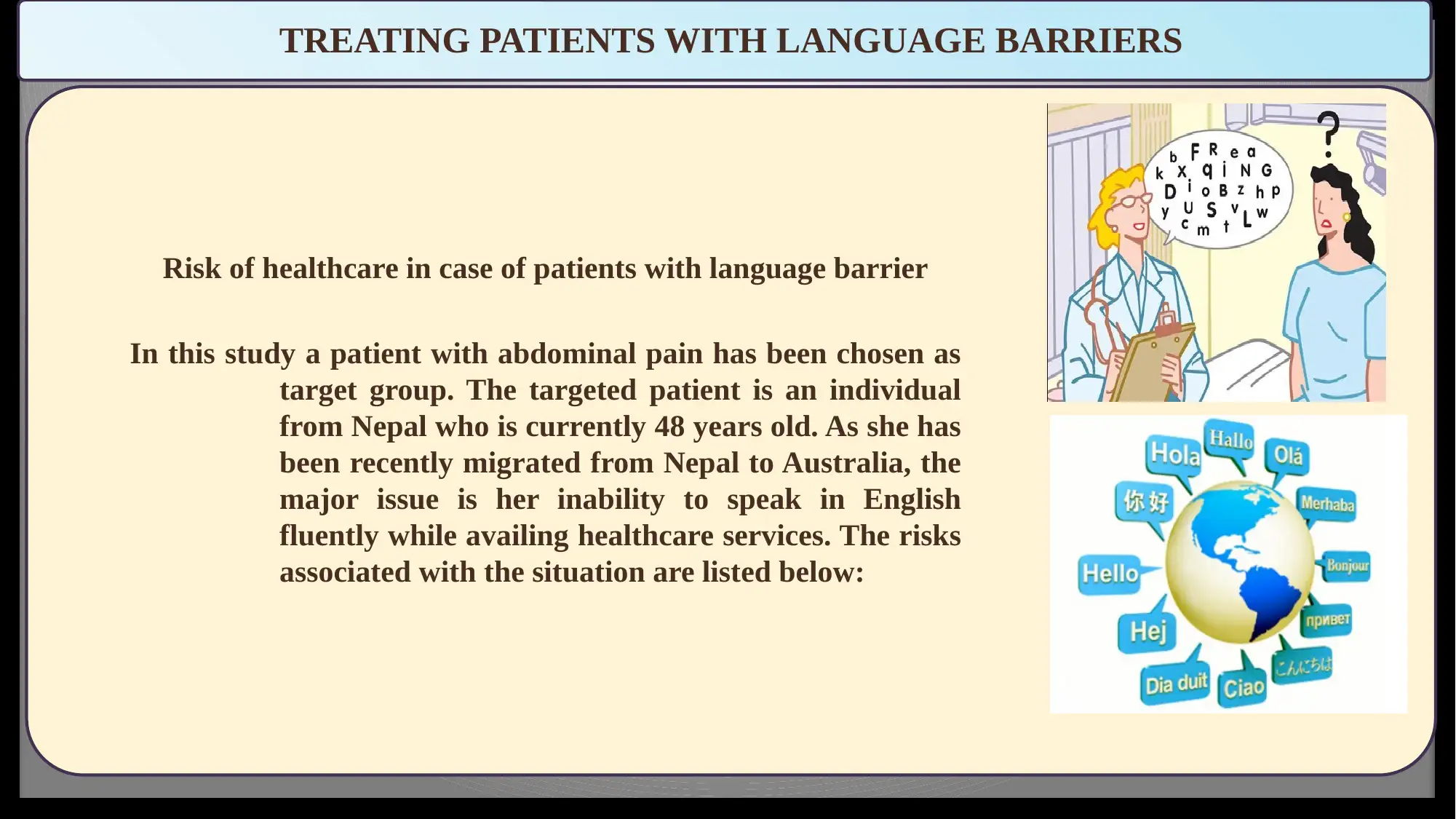
TREATING PATIENTS WITH LANGUAGE BARRIERS
Risk of healthcare in case of patients with language barrier
In this study a patient with abdominal pain has been chosen as
target group. The targeted patient is an individual
from Nepal who is currently 48 years old. As she has
been recently migrated from Nepal to Australia, the
major issue is her inability to speak in English
fluently while availing healthcare services. The risks
associated with the situation are listed below:
Risk of healthcare in case of patients with language barrier
In this study a patient with abdominal pain has been chosen as
target group. The targeted patient is an individual
from Nepal who is currently 48 years old. As she has
been recently migrated from Nepal to Australia, the
major issue is her inability to speak in English
fluently while availing healthcare services. The risks
associated with the situation are listed below:
Paraphrase This Document
Need a fresh take? Get an instant paraphrase of this document with our AI Paraphraser
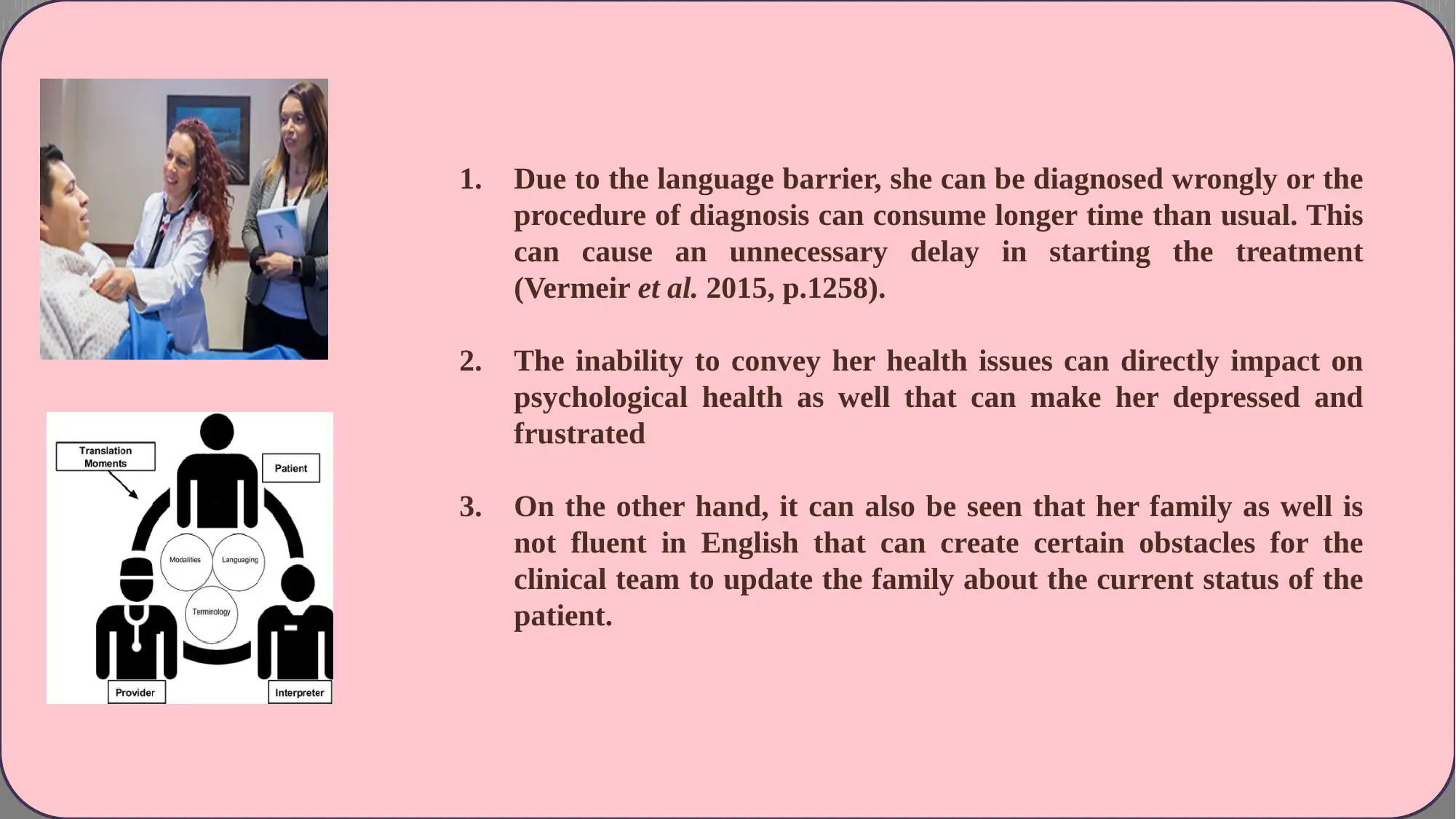
1. Due to the language barrier, she can be diagnosed wrongly or the
procedure of diagnosis can consume longer time than usual. This
can cause an unnecessary delay in starting the treatment
(Vermeir et al. 2015, p.1258).
2. The inability to convey her health issues can directly impact on
psychological health as well that can make her depressed and
frustrated
3. On the other hand, it can also be seen that her family as well is
not fluent in English that can create certain obstacles for the
clinical team to update the family about the current status of the
patient.
procedure of diagnosis can consume longer time than usual. This
can cause an unnecessary delay in starting the treatment
(Vermeir et al. 2015, p.1258).
2. The inability to convey her health issues can directly impact on
psychological health as well that can make her depressed and
frustrated
3. On the other hand, it can also be seen that her family as well is
not fluent in English that can create certain obstacles for the
clinical team to update the family about the current status of the
patient.
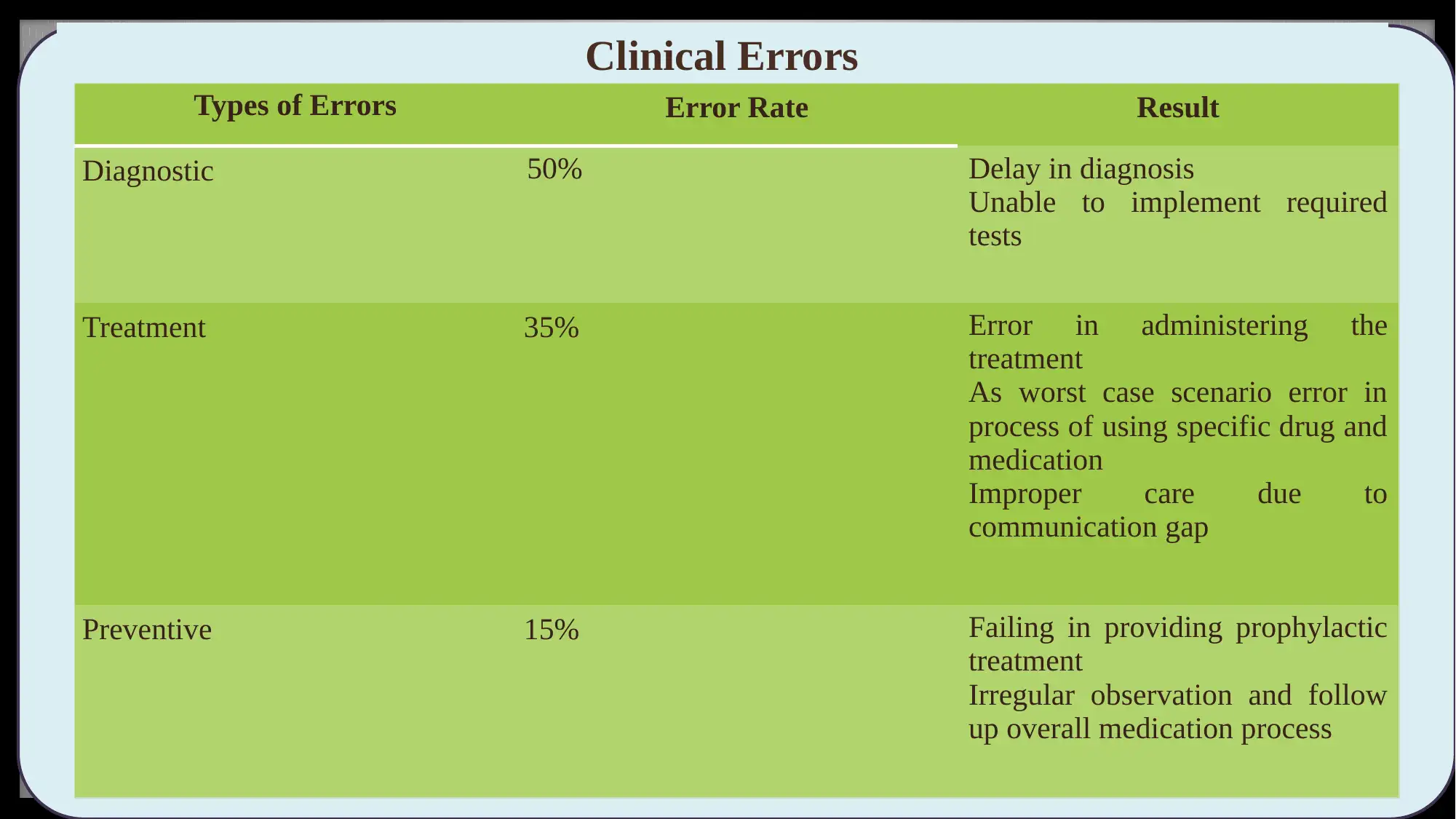
Clinical Errors
Clinical Errors
Types of Errors Error Rate Result
Diagnostic 50% Delay in diagnosis
Unable to implement required
tests
Treatment 35% Error in administering the
treatment
As worst case scenario error in
process of using specific drug and
medication
Improper care due to
communication gap
Preventive 15% Failing in providing prophylactic
treatment
Irregular observation and follow
up overall medication process
Clinical Errors
Types of Errors Error Rate Result
Diagnostic 50% Delay in diagnosis
Unable to implement required
tests
Treatment 35% Error in administering the
treatment
As worst case scenario error in
process of using specific drug and
medication
Improper care due to
communication gap
Preventive 15% Failing in providing prophylactic
treatment
Irregular observation and follow
up overall medication process
⊘ This is a preview!⊘
Do you want full access?
Subscribe today to unlock all pages.

Trusted by 1+ million students worldwide
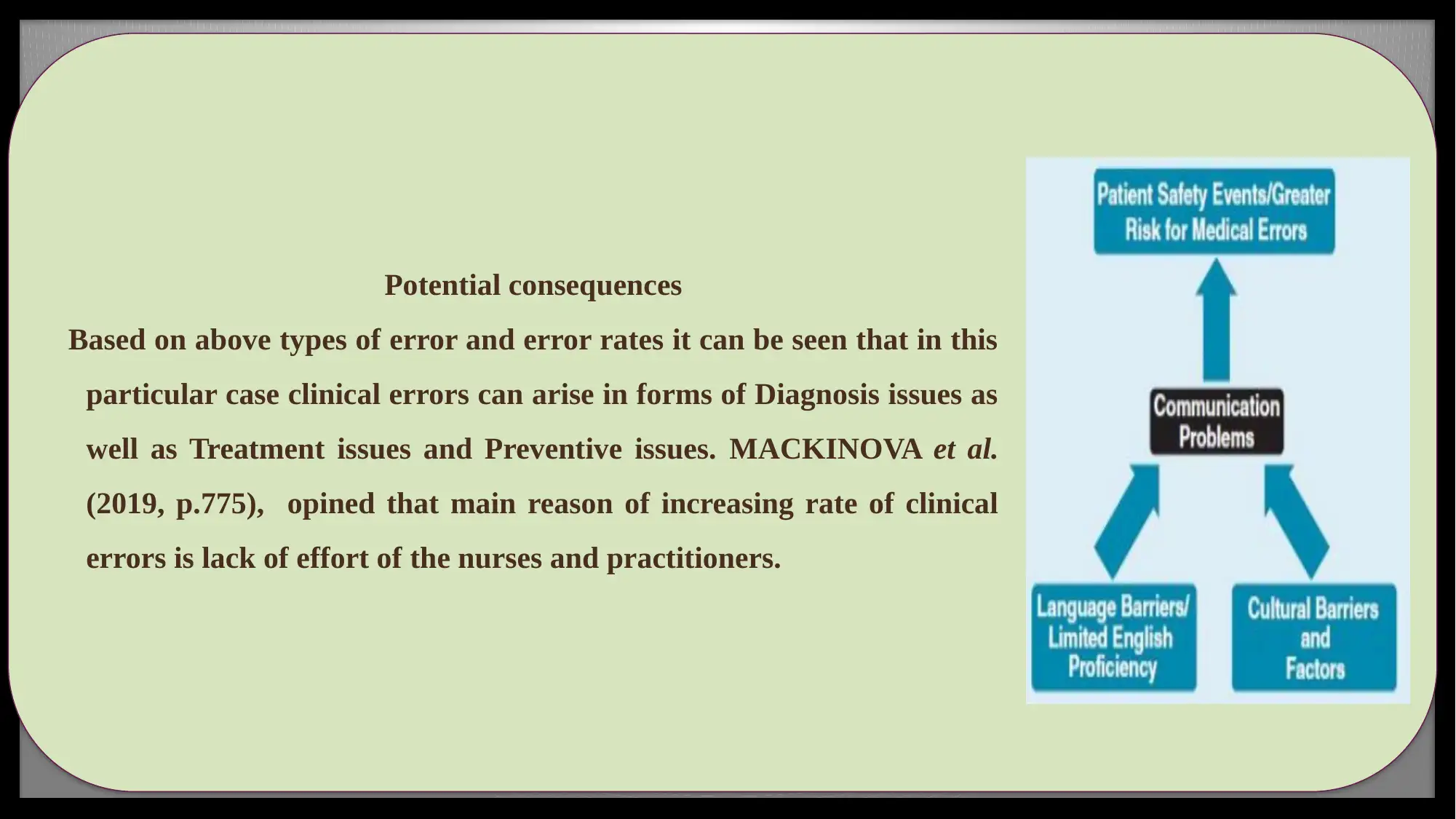
Potential consequences
Based on above types of error and error rates it can be seen that in this
particular case clinical errors can arise in forms of Diagnosis issues as
well as Treatment issues and Preventive issues. MACKINOVA et al.
(2019, p.775), opined that main reason of increasing rate of clinical
errors is lack of effort of the nurses and practitioners.
Based on above types of error and error rates it can be seen that in this
particular case clinical errors can arise in forms of Diagnosis issues as
well as Treatment issues and Preventive issues. MACKINOVA et al.
(2019, p.775), opined that main reason of increasing rate of clinical
errors is lack of effort of the nurses and practitioners.
Paraphrase This Document
Need a fresh take? Get an instant paraphrase of this document with our AI Paraphraser
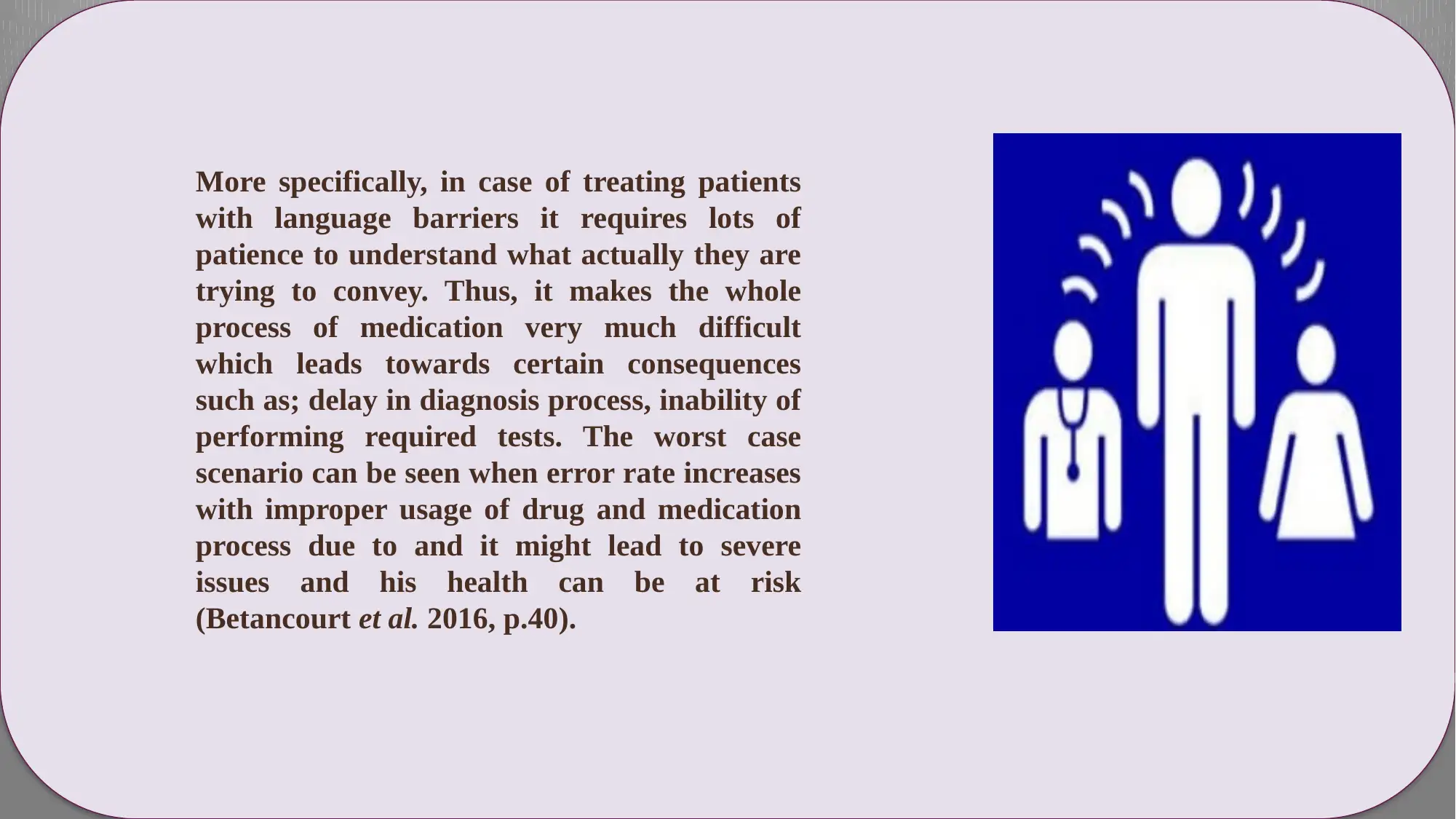
More specifically, in case of treating patients
with language barriers it requires lots of
patience to understand what actually they are
trying to convey. Thus, it makes the whole
process of medication very much difficult
which leads towards certain consequences
such as; delay in diagnosis process, inability of
performing required tests. The worst case
scenario can be seen when error rate increases
with improper usage of drug and medication
process due to and it might lead to severe
issues and his health can be at risk
(Betancourt et al. 2016, p.40).
with language barriers it requires lots of
patience to understand what actually they are
trying to convey. Thus, it makes the whole
process of medication very much difficult
which leads towards certain consequences
such as; delay in diagnosis process, inability of
performing required tests. The worst case
scenario can be seen when error rate increases
with improper usage of drug and medication
process due to and it might lead to severe
issues and his health can be at risk
(Betancourt et al. 2016, p.40).
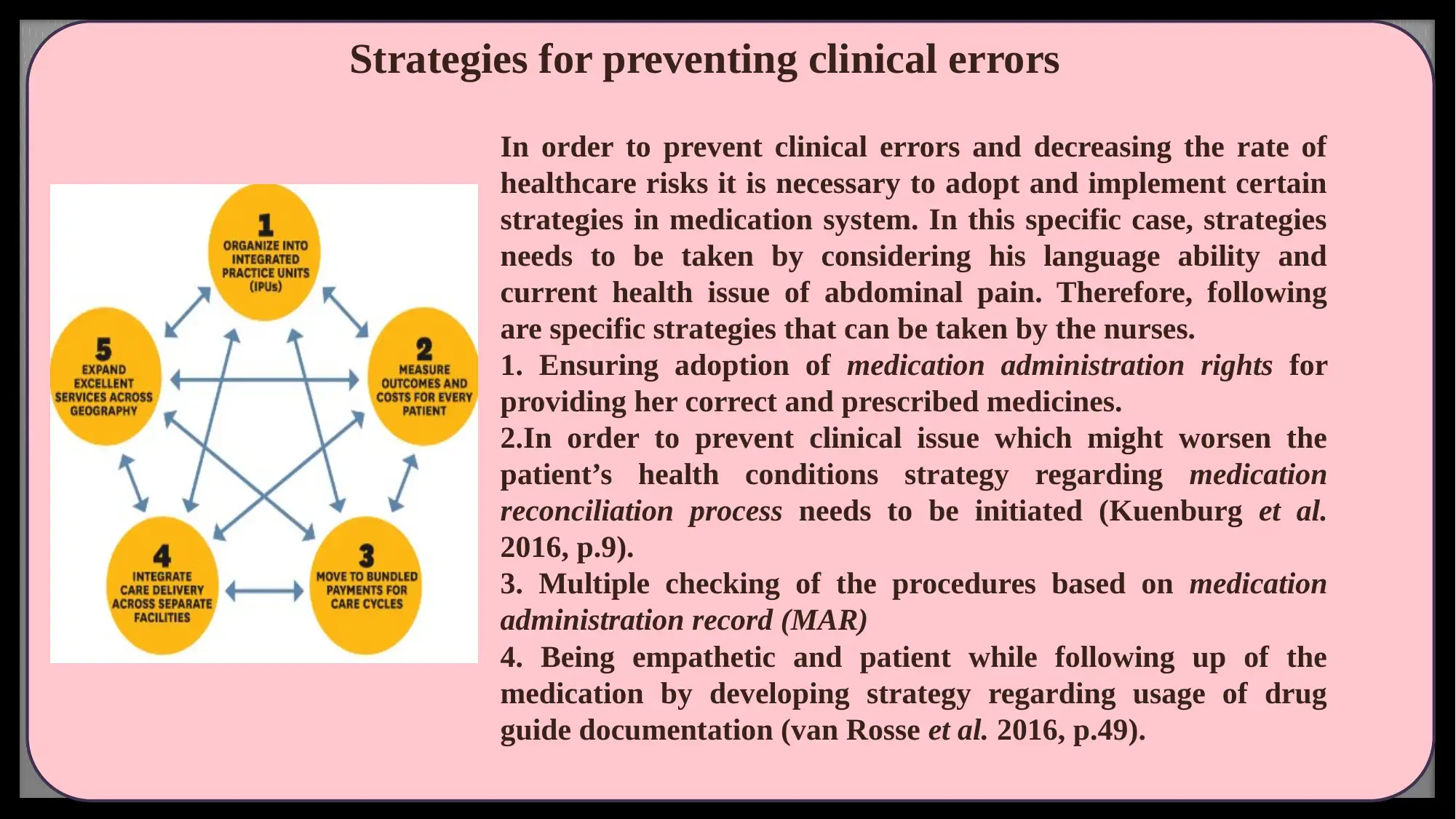
Strategies for preventing clinical errors
In order to prevent clinical errors and decreasing the rate of
healthcare risks it is necessary to adopt and implement certain
strategies in medication system. In this specific case, strategies
needs to be taken by considering his language ability and
current health issue of abdominal pain. Therefore, following
are specific strategies that can be taken by the nurses.
1. Ensuring adoption of medication administration rights for
providing her correct and prescribed medicines.
2.In order to prevent clinical issue which might worsen the
patient’s health conditions strategy regarding medication
reconciliation process needs to be initiated (Kuenburg et al.
2016, p.9).
3. Multiple checking of the procedures based on medication
administration record (MAR)
4. Being empathetic and patient while following up of the
medication by developing strategy regarding usage of drug
guide documentation (van Rosse et al. 2016, p.49).
In order to prevent clinical errors and decreasing the rate of
healthcare risks it is necessary to adopt and implement certain
strategies in medication system. In this specific case, strategies
needs to be taken by considering his language ability and
current health issue of abdominal pain. Therefore, following
are specific strategies that can be taken by the nurses.
1. Ensuring adoption of medication administration rights for
providing her correct and prescribed medicines.
2.In order to prevent clinical issue which might worsen the
patient’s health conditions strategy regarding medication
reconciliation process needs to be initiated (Kuenburg et al.
2016, p.9).
3. Multiple checking of the procedures based on medication
administration record (MAR)
4. Being empathetic and patient while following up of the
medication by developing strategy regarding usage of drug
guide documentation (van Rosse et al. 2016, p.49).
⊘ This is a preview!⊘
Do you want full access?
Subscribe today to unlock all pages.

Trusted by 1+ million students worldwide
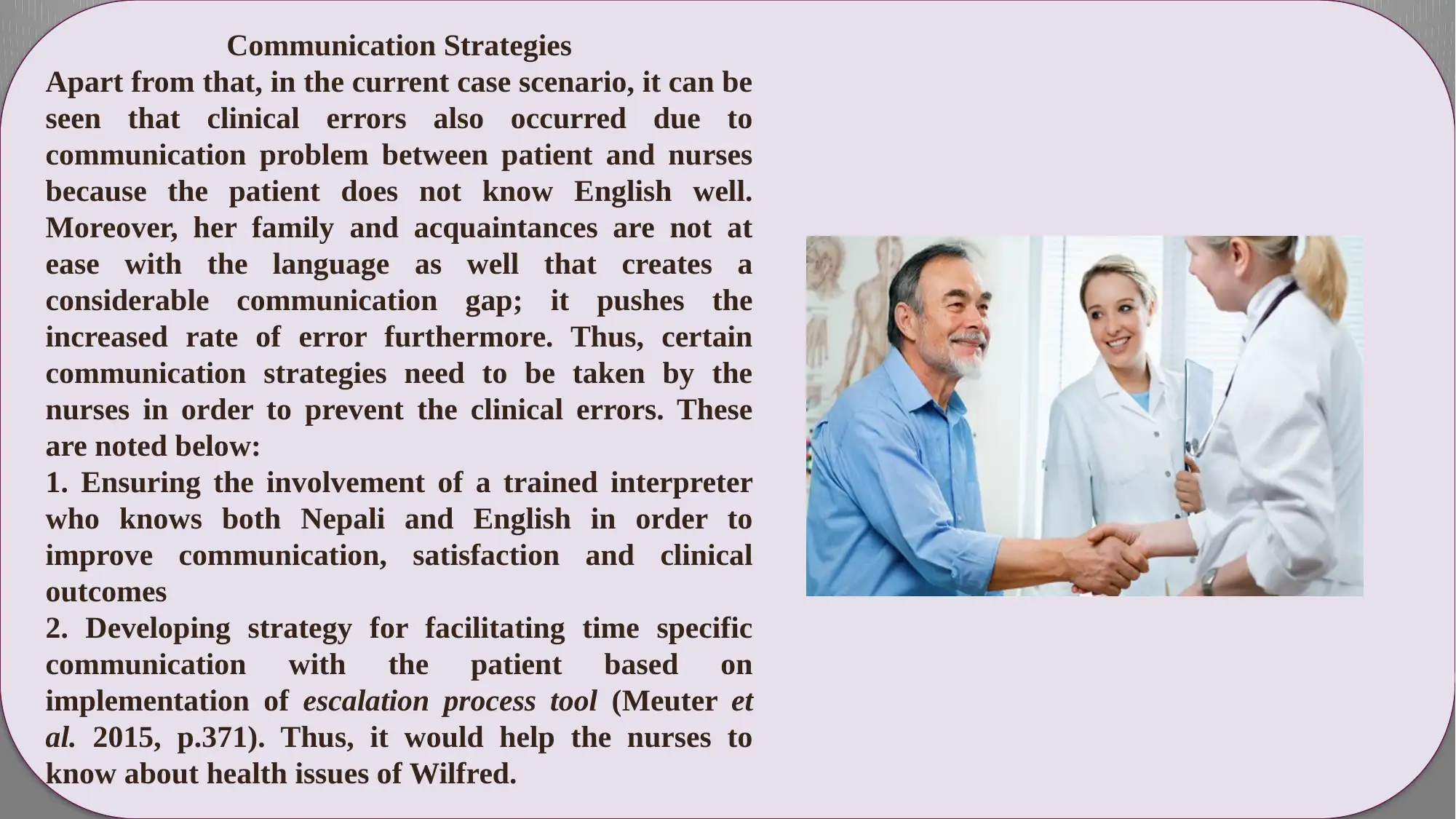
Communication Strategies
Apart from that, in the current case scenario, it can be
seen that clinical errors also occurred due to
communication problem between patient and nurses
because the patient does not know English well.
Moreover, her family and acquaintances are not at
ease with the language as well that creates a
considerable communication gap; it pushes the
increased rate of error furthermore. Thus, certain
communication strategies need to be taken by the
nurses in order to prevent the clinical errors. These
are noted below:
1. Ensuring the involvement of a trained interpreter
who knows both Nepali and English in order to
improve communication, satisfaction and clinical
outcomes
2. Developing strategy for facilitating time specific
communication with the patient based on
implementation of escalation process tool (Meuter et
al. 2015, p.371). Thus, it would help the nurses to
know about health issues of Wilfred.
Apart from that, in the current case scenario, it can be
seen that clinical errors also occurred due to
communication problem between patient and nurses
because the patient does not know English well.
Moreover, her family and acquaintances are not at
ease with the language as well that creates a
considerable communication gap; it pushes the
increased rate of error furthermore. Thus, certain
communication strategies need to be taken by the
nurses in order to prevent the clinical errors. These
are noted below:
1. Ensuring the involvement of a trained interpreter
who knows both Nepali and English in order to
improve communication, satisfaction and clinical
outcomes
2. Developing strategy for facilitating time specific
communication with the patient based on
implementation of escalation process tool (Meuter et
al. 2015, p.371). Thus, it would help the nurses to
know about health issues of Wilfred.
Paraphrase This Document
Need a fresh take? Get an instant paraphrase of this document with our AI Paraphraser
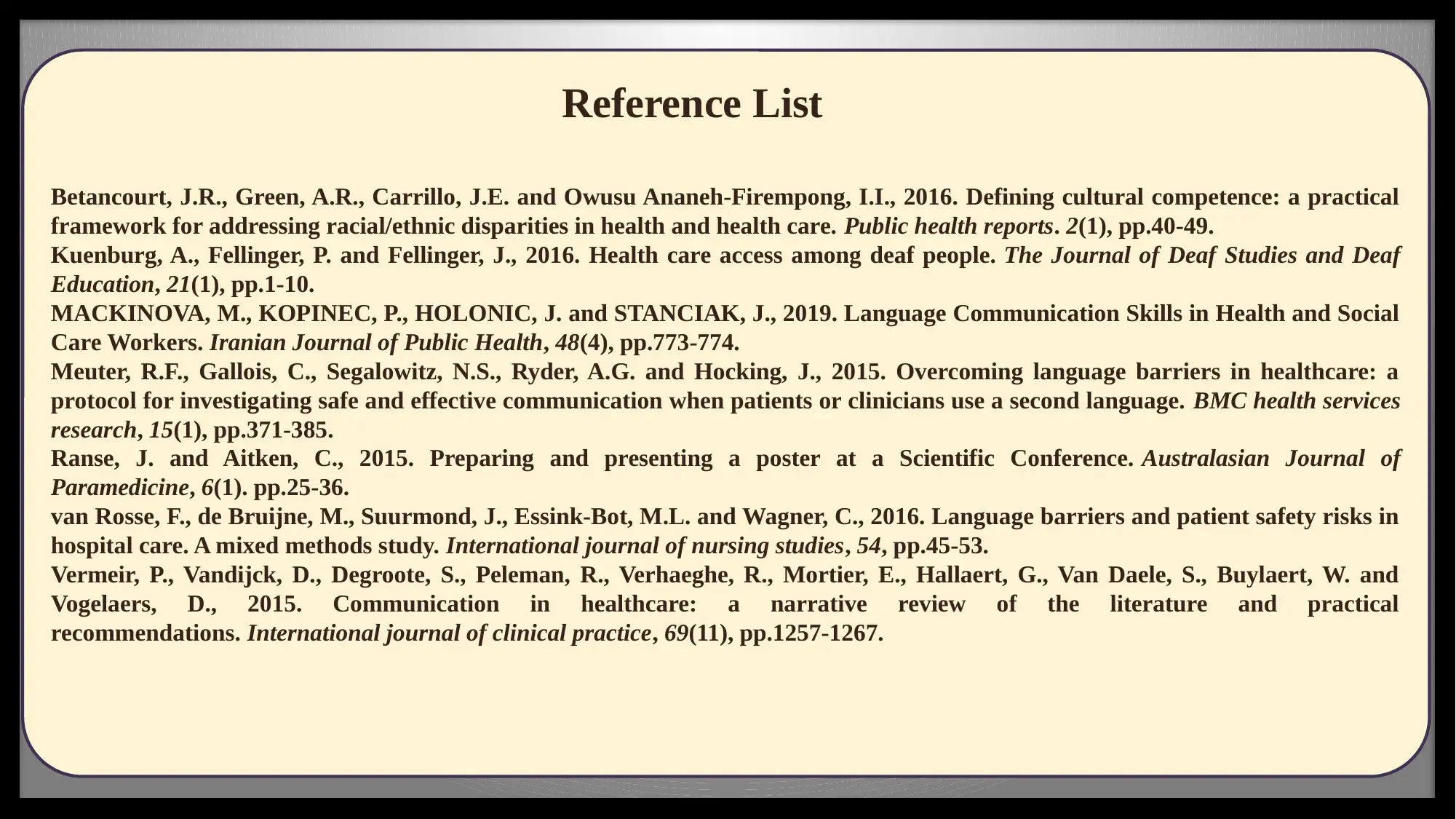
Betancourt, J.R., Green, A.R., Carrillo, J.E. and Owusu Ananeh-Firempong, I.I., 2016. Defining cultural competence: a practical
framework for addressing racial/ethnic disparities in health and health care. Public health reports. 2(1), pp.40-49.
Kuenburg, A., Fellinger, P. and Fellinger, J., 2016. Health care access among deaf people. The Journal of Deaf Studies and Deaf
Education, 21(1), pp.1-10.
MACKINOVA, M., KOPINEC, P., HOLONIC, J. and STANCIAK, J., 2019. Language Communication Skills in Health and Social
Care Workers. Iranian Journal of Public Health, 48(4), pp.773-774.
Meuter, R.F., Gallois, C., Segalowitz, N.S., Ryder, A.G. and Hocking, J., 2015. Overcoming language barriers in healthcare: a
protocol for investigating safe and effective communication when patients or clinicians use a second language. BMC health services
research, 15(1), pp.371-385.
Ranse, J. and Aitken, C., 2015. Preparing and presenting a poster at a Scientific Conference. Australasian Journal of
Paramedicine, 6(1). pp.25-36.
van Rosse, F., de Bruijne, M., Suurmond, J., Essink-Bot, M.L. and Wagner, C., 2016. Language barriers and patient safety risks in
hospital care. A mixed methods study. International journal of nursing studies, 54, pp.45-53.
Vermeir, P., Vandijck, D., Degroote, S., Peleman, R., Verhaeghe, R., Mortier, E., Hallaert, G., Van Daele, S., Buylaert, W. and
Vogelaers, D., 2015. Communication in healthcare: a narrative review of the literature and practical
recommendations. International journal of clinical practice, 69(11), pp.1257-1267.
Reference List
framework for addressing racial/ethnic disparities in health and health care. Public health reports. 2(1), pp.40-49.
Kuenburg, A., Fellinger, P. and Fellinger, J., 2016. Health care access among deaf people. The Journal of Deaf Studies and Deaf
Education, 21(1), pp.1-10.
MACKINOVA, M., KOPINEC, P., HOLONIC, J. and STANCIAK, J., 2019. Language Communication Skills in Health and Social
Care Workers. Iranian Journal of Public Health, 48(4), pp.773-774.
Meuter, R.F., Gallois, C., Segalowitz, N.S., Ryder, A.G. and Hocking, J., 2015. Overcoming language barriers in healthcare: a
protocol for investigating safe and effective communication when patients or clinicians use a second language. BMC health services
research, 15(1), pp.371-385.
Ranse, J. and Aitken, C., 2015. Preparing and presenting a poster at a Scientific Conference. Australasian Journal of
Paramedicine, 6(1). pp.25-36.
van Rosse, F., de Bruijne, M., Suurmond, J., Essink-Bot, M.L. and Wagner, C., 2016. Language barriers and patient safety risks in
hospital care. A mixed methods study. International journal of nursing studies, 54, pp.45-53.
Vermeir, P., Vandijck, D., Degroote, S., Peleman, R., Verhaeghe, R., Mortier, E., Hallaert, G., Van Daele, S., Buylaert, W. and
Vogelaers, D., 2015. Communication in healthcare: a narrative review of the literature and practical
recommendations. International journal of clinical practice, 69(11), pp.1257-1267.
Reference List
1 out of 8
Related Documents
Your All-in-One AI-Powered Toolkit for Academic Success.
+13062052269
info@desklib.com
Available 24*7 on WhatsApp / Email
![[object Object]](/_next/static/media/star-bottom.7253800d.svg)
Unlock your academic potential
Copyright © 2020–2025 A2Z Services. All Rights Reserved. Developed and managed by ZUCOL.





